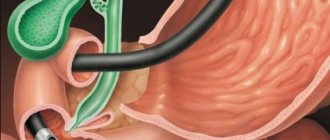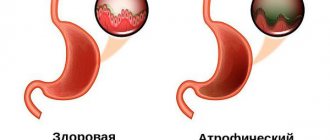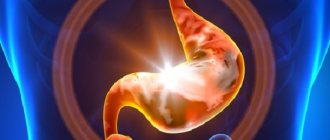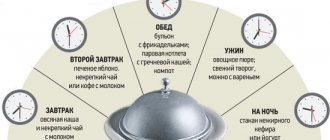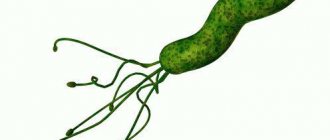The causes of gastritis in dogs and humans are similar. The difference lies only in the frequency of occurrence of the disease and the form of its course. Despite the rarity of this diagnosis, most four-legged pets go to the veterinarian for examination in a very serious condition.
The thing is that they cannot tell their owners about their illness. Because of this, the disorder is detected only at the stage of the appearance of an extensive ulcer, when the pain from irritation of the mucous membrane becomes unbearable.
What is gastritis and what can it look like?
The pathology affects the gastric mucosa. As a result of an extensive inflammatory process, regeneration slows down, so fibrous tissue grows in place of the affected cells. It disrupts secretory function, deviating the acidity (pH) of gastric juice from its norm.
Low pH levels interfere with digestion and impair motility. The food that accumulates inside begins to rot, causing acute poisoning of the entire body.
The situation with elevated pH levels is no less dangerous. The formation of an overly aggressive environment leads to the dissolution of one’s own tissues. Erosion and ulcers form on the mucous membrane, causing internal bleeding and adhesion to neighboring organs.
In its symptoms, the disease resembles a gastric ulcer. In both cases, severe pain is observed. The difference lies in the periods of exacerbation. With gastritis, the pain is constant, but with an ulcer, its appearance is influenced by the time of year, day and feeding. Most often it reminds itself of itself in the fall, spring, at night and immediately after eating.
Diagnosis of chronic gastritis
To exclude systemic diseases, clinical and biochemical blood tests and a clinical urine test are performed. Plain radiography can detect a violation of the evacuation of food from the stomach, and the use of contrast can be informative in the formation of ulcers, thickening of the mucous membrane and folds of the stomach.
The most informative study for suspected chronic gastritis is endoscopy (gastroscopy), which allows not only to examine the condition of the stomach from the inside, but also to take samples of the contents and tissues of the stomach for bacteriological, serological or histological analysis.
Common causes of the disease
All causes of gastritis in dogs are divided into primary and secondary. The first include feeding disorders, poisoning and injury, that is, external factors. The second group includes parasitosis and infections. In these diseases, inflammation of the mucous membrane develops as a complication, so its treatment cannot be done without eliminating the root cause.
Feeding disorders
Most often, the owner is to blame for the pet’s illness because he neglects feeding recommendations. The stomach of a quadruped can suffer if the following mistakes are made:
- Exceeding the daily feed allowance
. Consistent overfeeding leads not only to weight gain, but also to gastrointestinal pathologies. The incoming food does not have time to be digested, so the stomach stretches to store it.
- Regular consumption of prohibited foods
. Food from the human table is rich in spices and additives harmful to dogs. Also, the mucous membrane can be injured by sharp bones.
- Burning or hypothermia
too hot and cold pieces of food. The optimal temperature for food is room temperature.
- Abrupt transition to a new type of feeding
or for food of lower quality.
- Rare water change
or lack of filtering. By drinking stagnant water poured from the tap, the dog runs the risk of becoming infected with pathogenic microorganisms or being poisoned by harmful impurities.
- Wrong mode
. If the animal is fed whenever it has to, digestion is disrupted and cannot maintain cycles. An adult dog should be given food twice a day, at intervals of 12 hours.
Due to the variability of possible causes related to feeding, when preventing the disease, the main emphasis is on creating a safe and balanced diet.
Poisoning
In addition to spoiled food found in the trash, a dog can be poisoned by poison, household chemicals or medications. All potentially hazardous substances should be kept in a locked area away from the floor.
Stomach injuries
The mucous membrane can be injured when struck or swallowed by a sharp object. In addition to bones, any small objects, including parts from children's construction sets, pose a danger.
Parasitoses
Helminthic infestation is always accompanied by intoxication. The waste products of parasites negatively affect the mucous membrane, causing its destruction and inflammation.
Impact of infections
The main culprit of stomach inflammation in humans is infection with the bacterium Helicobacter pylori. This pathogen is less common in domestic animals. In most cases, the secondary cause is parvovirus infection, leptospirosis, distemper and adenovirosis. That is why they are vaccinated against all these diseases as early as 2-2.5 months.
How to reduce the likelihood of developing gastritis?
Remember that it is easier to avoid a disease than to cure it. Veterinarians have prepared several useful recommendations that will help avoid the development of gastritis in your pet. And the very first of them concerns the dog’s nutrition. To prevent stomach inflammation, select only high-quality food and do not give your pet food from the table.
Other prevention recommendations:
- Do not mix natural and industrial food. Decide what your pet’s diet will be, taking into account its individual characteristics.
- Keep a close eye on your dog while walking. She should not pick up unfamiliar objects or try to swallow them.
- Visit your veterinarian regularly. This is necessary for vaccination and anthelmintic therapy.
- Don't forget about hygiene procedures. An animal can bring pathogenic bacteria from the street onto its paws and fur.
- Never self-medicate or give medications from your home medicine cabinet. If you have any suspicious symptoms, contact your veterinarian.
Remember that the dog's health largely depends on your attention and care. Do not ignore the signs of gastritis - if you have any suspicions, contact a veterinary clinic and begin treatment!
Main signs and symptoms
The main sign of gastritis in dogs is vomiting. Because of this, the disease is often confused with poisoning or a cold.
Nausea is accompanied by lethargy and loss of activity. A sick pet refuses to play together and reluctantly goes out for a walk. With the onset of pain, he becomes irritable and aggressive. Such mood swings are easy to notice in good-natured animals who never snap at their owners.
Over time, appetite also disappears. Despite this, the desire to eat remains, but due to unpleasant sensations, most of the food remains in the bowl. Due to intoxication, severe thirst appears and the temperature rises.
More alarming symptoms appear only after a few days, when the mucous membrane receives significant damage. These include:
- significant weight loss;
- constipation or diarrhea (feces may contain undigested pieces of food or traces of blood);
- noticeable muscle tension in the abdomen (when touched, the patient grins threateningly, growls or whines);
- increased frequency of vomiting, changes in the color of the vomit to yellow or red, as well as regurgitation after each feeding;
- dulling of the coat;
- the smell of rot from the mouth and the appearance of a whitish or grayish coating on the tongue.
If you notice any of the above symptoms, be sure to schedule your pet for examination. Prolonged pathology is fraught with gastric volvulus and other dangerous complications.
Prevention
To avoid re-exacerbation, you need to reconsider your dog care:
- food is either premium quality food or completely balanced natural food;
- never give "human" food, even if it's just soup. We salt our food and add spices, but this is contraindicated for a dog;
- Dogs are not allowed bones. If you previously gave your pet bones to clean its teeth, you should replace them with special bones from the pet store;
- deworm regularly;
- get all vaccinations according to schedule;
- you cannot self-medicate for any disease;
- bathe your dog and comb its fur so that it does not lick itself and its stomach does not become clogged with hairballs.
If symptoms reappear, you should contact your veterinarian.
Classification of pathology
Depending on the form of the course, the pH level and the root cause, the disease is divided into several varieties. They all have different treatments and prognoses, so don't try to deal with the problem on your own.
According to the flow form
Gastritis in dogs can be acute or chronic. In the first case, there is a clear clinical picture and a sharp deterioration in the condition, and in the second, a series of remissions and relapses. If treatment is delayed, the acute form becomes chronic, which significantly worsens the prognosis for recovery.
According to stomach acidity
When the pH deviates above the norm, the pathology is called hyperacid, and when the pH deviates below the norm, it is called hypoacid. If the acidity level remains within standard values, then the animal is diagnosed with normacid inflammation.
Due to the appearance
Another 5 types of disease are determined by its cause. These include:
- hypoxemic, developing with heart pathologies against the background of prolonged hypoxia (lack of oxygen);
- eosinophilic, diagnosed when eosinophils grow due to parasitosis and allergic reactions;
- endogenous, arising from vitamin and mineral deficiencies;
- uremic, appearing in liver diseases;
- lymphoplasmacytic, found in autoimmune disorders.
The pet may also be diagnosed with an idiopathic type. It is indicated when the exact cause of origin remains unknown even after testing. In this case, treatment is carried out according to the general scheme.
Gastritis in dogs
Gastrointestinal diseases among dogs are quite common. They can occur both at an early and late age. Unfortunately, pathological changes in the stomach develop very quickly. One of the most common gastrointestinal diseases is gastritis. Gastritis is an inflammation of the stomach lining. First, tissue hyperemia appears, the mucous membrane thickens, abundant production of thick translucent mucus occurs, later infiltration of tissues around the vessels, death of glands and degeneration of the integumentary epithelium are observed. The pyloric part of the stomach (closest to the duodenum) is most affected. The stomach tissues become swollen. The secretory, motor and absorption functions of the stomach are impaired. Because of this, the food in the stomach undergoes fermentation and rotting, which leads to the appearance of an unpleasant odor from the dog’s mouth. Stomach pain with gastritis is usually explained by spasm of the pylorus (the valve that separates the stomach from the duodenum). Irritation of the mucous membrane reflexively excites the vomiting center, causing the animal to feel nauseated.
Causes of gastritis in dogs
- Poor nutrition. This includes feeding low-quality (spoiled) food, an unbalanced diet and feeding the dog foods that are unusual for the species (sausage, sweets, etc.)
- Feeding your dog food that is too hot or cold (especially frozen food).
- Keeping a dog in unsanitary conditions.
- Poor drinking water, shortage or lack of water.
- The bacterium Helykobakter pylori - recently it has been assigned a large role in the occurrence of ulcerative nastritis.
- Weakening of the immune system and gastritis can be a secondary process in infectious (plague, parvovirus enteritis, leptospirosis, tularemia, botulism) and non-infectious (poisoning, sepsis, trauma) diseases.
- A sharp transition from industrial feed to natural food and vice versa; a sharp transition from mother's milk to feed.
- Taking certain medications (salicylates, sulfonamides, glucocorticoids, indomethacin, ortofen).
Symptoms of gastritis
- Lethargic, depressed state of the animal, fatigue.
- Belching
- Vomiting (possibly with mucus, blood, bile) after eating and drinking.
- A slight, and often short-term, increase in temperature is possible.
- Restlessness after eating.
- Forced posture - arched back, tucked stomach.
- Decreased and distorted appetite, refusal to feed.
- Loss of body weight, the dog noticeably loses weight.
- White coating on the tongue.
- Viscous, viscous saliva. Bad breath.
- The stool is dark in color, thick in consistency, and may contain mucus.
- Palpation of the stomach in the area of the left costal arch is painful for the dog.
How to recognize gastritis at home
Regular monitoring of the dog will help in this matter. As a rule, it all starts with periodic refusal of food and loss of appetite. The dog eats reluctantly, but becomes more alert from time to time. However, the owner soon notices that the pet has begun to lose weight, the fur has become dry and disheveled. Look at your dog's tongue - a gray or off-white coating on it may indicate stomach problems. An unpleasant odor from the mouth is also a sign of pathology. Also, do not ignore your dog's vomiting. It is believed that in the vast majority of cases it is caused by gastritis. At the same time, many owners believe that the dog is vomiting because it “ate something wrong.” I would like to note that vomiting is not such a harmless symptom and cannot be ignored.
Forms of gastritis according to the course
Spicy
– a first-time inflammatory process accompanied by severe symptoms.
Chronic
- is a continuation of acute in the absence of treatment. It lasts a long time, exacerbations alternate with remissions. It can lead to very serious consequences: the appearance of ulcers, erosions, and neoplasms.
Types of gastritis according to the nature of inflammation
Catarrhal gastritis is the most common type. It is characterized by increased gastric tone, increased peristalsis, swelling of the folds of the mucous membrane, and gastric spasm.
Atrophic gastritis - flattening and disappearance of mucosal folds, decreased tone and secretion.
Hypertrophic gastritis - thickening and compaction of folds, increasing their severity.
Croupous gastritis is a very rare form in which films consisting of fibrin form on the gastric mucosa.
Diphtheric gastritis - occurs in severe infectious diseases and chemical poisoning.
Hemorrhagic gastritis is gastritis with foci of hemorrhage on the gastric mucosa.
Erosive-ulcerative gastritis is the formation of defects in the gastric mucosa.
Gastritis with high and low acidity
Gastritis with high acidity is called hyperacid. Gastritis with low acidity is called hypacid. Differentiating these two types of disease is important for drawing up a competent treatment plan.
| Hypacidal gastritis (low acidity) | Hyperacid gastritis (acidity increased) | |
| Chair | Diarrhea, large amounts of mucus and undigested food particles are present in the excrement. | Constipation |
| Peristalsis | Increased peristalsis is observed | There is a weakening of peristalsis |
| Other symptoms | Bloating, noisy rumbling in the stomach | Vomiting and belching after eating |
| Treatment | Replacement therapy, stimulation of secretion, improvement of microcirculation, antispasmodics, prokinetics, vitamins. | Anticholinergics, proton pump inhibitors, antacids, gastroprotectors (enveloping, astringent, film-forming drugs), if Helicobacter pylori is detected - antibiotics. |
Gastroscopy
Blood tests and x-rays do not allow a diagnosis to be made with 100% certainty. The best method for diagnosing gastritis is gastroscopy. A thin probe is inserted into the stomach through the esophagus, allowing you to examine the surface of the mucosa, take a biopsy (tissue sample for analysis), and detect a foreign object. Gastroscopy is completely safe for dogs and takes literally a few minutes.
Treatment of gastritis in dogs
At the beginning of treatment, it is very important to establish what exactly led to the development of gastritis. The factor that provoked the disease must be eliminated. Only in this case will the treatment bear fruit. The leading method of treating gastritis is dietary feeding
.
It is very useful to give your dog decoctions and infusions of medicinal herbs
that have anti-inflammatory, astringent, and enveloping properties.
Medicines
are also prescribed : Pepsin, Abomin, Trypsin, Pancreatin, Mezim, Pepsidil, Himopsin, Chymotrypsin, Essentiale Forte, Panzinorm Forte.
If the dog is obviously experiencing discomfort (nausea, pain), drugs such as Phosphalugel, Almagel, Imodium, etc. are prescribed. To cleanse
the gastrointestinal tract, activated charcoal, enterosorbents, Enterozoo, Vetsorbin are prescribed.
To relieve spasms - antispasmodics
No-shpa, Spazmalgon, Spazgan.
Antibiotics
are also prescribed according to indications .
They are mainly used in cases where gastritis is of a bacterial nature and develops due to the microorganism Helicobacter pylori. To relieve pain, analgesics
- Baralgin.
Also, in some cases, antihistamines are used -
Tavegil , Suprastin if an allergy is suspected.
In parallel with the treatment, the dog is prescribed vitamin
preparations for a period of 14-30 days.
What to feed a dog with gastritis
After diagnosis, the dog is advised to fast for 12-24 hours. The gastrointestinal tract will be able to recover during the rest period. Water is not limited. If your dog has diarrhea, give a rehydration solution (it prevents dehydration).
In a day
The dog is given chicken or beef broth.
For 2-3 days
The dog is given raw eggs, 1-3 eggs per day depending on the size of the animal.
For 3-4 days
You can give rice or oatmeal. They are boiled in water or broth (not milk). The consistency of the porridge should be liquid.
The next day
A small amount of minced meat (chicken or beef, boiled) is added to the porridge. Depending on the size of the minced animal, add a teaspoon or a tablespoon. Next, the reaction is observed; if there is no vomiting or diarrhea, the amount of meat in the diet can be gradually increased.
Starting from day 5
Dairy products are introduced into the diet: kefir, yogurt, acidophilus, porridge with milk. You can also give semolina, millet, and buckwheat porridge.
On the 7th day
Vegetables are added to the diet - potatoes, cabbage, carrots.
If by the 10th day
The dog does not have any digestive problems; it is transferred to a normal diet.
Traditional methods of treating gastritis
Medicinal plants can be a good help in the treatment of gastritis. Oak bark, decoction of bird cherry, alder, juniper fruits, tincture of burnet, calendula, St. John's wort, and wormwood are widely used. For constipation, you can use laxatives of plant origin - rhubarb root, buckthorn fruit, senna leaf, cumin and fennel fruits. An infusion of belladonna (belladonna) is used as a pain reliever, as well as so-called stomach drops - tincture of valerian, peppermint, wormwood, and belladonna.
Prevention of gastritis in dogs
The best way to prevent gastritis, and many other gastrointestinal diseases, is adequate feeding, taking into account age and stress. The second component of a dog’s health is adequate daily exercise. Of course, the conditions under which animals are kept matter. The place where the dog lives should be dry, warm enough, and protected from drafts. It is best to feed your dog 2-3 times a day. With a single feeding, the stomach may be overloaded due to the large volume of food eaten. The dog should always have access to clean drinking water, preferably at room temperature. It is strictly not recommended to include the following foods in your dog’s diet:
- Sweets and confectionery
- Canned food
- Sausages, nipples, etc.
- Smoked meats
- High fat foods
- Pork
- Feed with mechanical impurities (dust, sand, chemicals)
Forecast
If the dog receives the necessary treatment, the prognosis will be more than favorable. As a rule, recovery occurs within 1-2 weeks. The situation is much more serious if the dog does not receive veterinary care and the owner does not take measures to cure it. The inflammation will go into a chronic phase and will bother the dog for several months or even years. The pet's condition will change: periods of exacerbations alternate with periods of remission. Gastritis itself is not a fatal disease. Today, both acute and chronic gastritis can be successfully treated. But if treatment is neglected, a number of dangerous complications may develop: stomach ulcers, hypovitaminosis, pancreatitis, stomach cancer. Some of these diseases are fatal, and therefore at the first signs of gastritis it is necessary to normalize the dog’s diet and contact a veterinarian.
What tests need to be taken for diagnosis?
To make a diagnosis, you will need to undergo urine and blood tests, ultrasound, x-rays, biopsy and endoscopy. Based on the results of these studies, the doctor will be able to determine the source of the disease, the condition of the mucous membrane, the level of acidity and associated disorders.
Diagnosis of acute gastritis
For the diagnosis of acute gastritis, anamnesis is of great importance. If the owner can accurately and reliably tell about the life of his pet: what he eats, whether he can get to a garbage can and various chemicals, whether he picks up on the street, whether he chews toys and sticks, when the vomiting started, how the stool has changed - then this greatly simplifies and speeds up the process. searching for the cause of the disease.
For diagnosis, clinical and biochemical blood tests, ultrasound examination of the abdominal cavity, and sometimes (especially if the presence of foreign bodies is suspected) X-ray examination with contrast are usually performed. Sometimes a gastroscopy is required.
Therapy prescribed by a veterinarian
Drug treatment of gastritis in dogs is carried out at home. Hospitalization is recommended only for those who cannot feed themselves due to frequent bouts of vomiting.
The list of medications used is selected individually based on the cause of the disease and its symptoms. Most often used:
- anti-ulcer to lower pH levels;
- anthelmintics and antibiotics;
- antacids with an enveloping effect;
- immunomodulators and vitamins;
- antiemetics;
- digestive enzymes;
- antispasmodics and analgesics;
- antihistamines and glucocorticosteroids that suppress allergic reactions and the immune response;
- laxatives or fixatives;
- hemostatic.
Folk remedies include St. John's wort, blueberries, oak bark and flax seeds. Decoctions from these plants make it difficult to absorb toxins and protect the nerve endings of damaged tissues.
What to do if your dog is poisoned
Vomiting, diarrhea - symptoms of poisoning in a dog and treatment are prescribed based on their nature. If the animal simply ate low-quality food, you can limit yourself to sorbents - activated carbon, Sorbex.
When she becomes a victim of a dog hunter or accidentally licks poison, immediately consult a doctor. How to treat at home if your dog is poisoned, see the symptoms.
The dog was poisoned with isoniazid, what to do at home
If she swallowed isoniazid (a medicine for tuberculosis), the vomit will be bloody, foamy, and profuse salivation. Convulsions, drowsiness, and problems with coordination will appear.
Always keep a solution of vitamin B6 (1%) in your first aid kit and give an injection based on your pet’s weight (1 ml per 5 kg). If the dog is conscious, flush the stomach by inducing vomiting. Give the animal any sorbent. Take him to the clinic right away.
Rat poison
Symptoms of rat poison poisoning:
- blood in stool, vomit;
- nosebleeds;
- the smell of garlic from the mouth;
- heat.
If a dog is poisoned by rat poison, treatment is prescribed based on the situation. If your pet ingested poison less than 4 hours ago, rinse the stomach. If more time has passed, this cannot be done - the poison is already in the intestines.
Give your dog a laxative, give him an enema, or give him a vitamin K injection to improve blood clotting. After this, immediately consult a doctor; treatment may require a transfusion.
What to do when the threat to life passes
The dog should be on a diet for some time. Light feeding - broth, crackers (the doctor will give additional recommendations). On the fifth day you can increase the portions.
Basic principles of a therapeutic diet
Treatment is not complete without diet. Depending on the form of gastritis in the dog, the doctor decides what to feed it until it recovers. In case of chronic pathology, the diet must be adhered to throughout life.
Diet in acute form
The pet is deprived of any food for a day, and then gradually transferred to fractional meals. Before serving, all food is ground or mashed to a puree consistency. Dry granules are soaked in warm water or replaced with wet canned food. They begin to return to the usual menu on the 3-4th day, adding small pieces of meat to slimy porridges and starchy foods.
Diet for chronic form
Fasting is not practiced. The diet is less strict than in the acute form. The consumption of difficult-to-digest foods is excluded, but animal protein in the form of scrambled eggs and grated cheese is encouraged. All food is served boiled or stewed 3-5 times a day. Additional restrictions are imposed only if a relapse occurs.
Prohibited Products
The prohibited list includes any dishes from the human table and some products
:
- fatty meats and fish, as well as broths based on them;
- eggs (except egg white omelet);
- dry food;
- large bones;
- milk;
- sorrel, white cabbage, peas, turnips, mushrooms, garlic and onions;
- salty and spicy cheeses;
- fermented milk products with high fat content;
- millet, pearl barley and corn porridge;
- large bones.
Try to avoid overfeeding. Excessive production of gastric juice can aggravate the existing problem.
Allowed products and feed
Product safety is determined by pH level. If the value is low, it is recommended to eat bean puree, low-fat meat and fish broths, fermented milk products with low fat content, eggs and juices from beets or cabbage.
If the pH is higher than normal, then it is lowered to the desired value with watery porridges from rice and rolled oats, juices from carrots and potatoes, small pieces of lean boiled meat or fish.
When dry feeding, the animal is transferred to specialized food marked i/d. They reduce the load on the gastrointestinal tract and restore the intestinal microflora.
Dietary food: features and rules
It is always necessary to provide your dog with a proper diet, and even more so if you have gastritis. If your pet is accustomed to dry food, then choose diets from special dietary lines. Before doing this, be sure to consult a specialist.
Features of dietary nutrition for gastritis:
- Eliminate fish and meat completely . You can introduce them back into the diet from 10-14 days of gastritis treatment, but only in the form of minced meat (for example, mixed with liquid porridge).
- Add steamed vegetables to your diet. Prohibited vegetables include potatoes, tomatoes, peppers, as well as onions and garlic.
- Give your pet vegetable broths and herbal decoctions . This will ensure rapid recovery of his body.
- Introduce porridge into your diet . Veterinarians recommend giving your dog rice and oatmeal, previously diluted with warm water to a semi-liquid state.
Consequences and forecasts
Most often, complications arise in the chronic form, as it is always accompanied by relapses. Possible consequences include:
- tooth loss;
- alopecia;
- gastric hemorrhage;
- development of ulcers;
- deterioration of hearing and vision;
- intestinal obstruction;
- volvulus of the stomach.
Despite this, most cases of gastritis in dogs are treatable. An unfavorable prognosis is typical only in the presence of renal failure, as well as in the eosinophilic and lymphoplasmacytic varieties.
How to give medicine to a dog
Liquid medicine is easy to give. Fill it into a syringe without a needle, insert it between your pet's teeth, and squeeze out the drug. The dog will definitely swallow the liquid, and with it the healing agent.
If the medicine is in powder form, add it to the minced meat. The animal will happily eat the meat and will not notice the drug.
With hard tablets the situation is more difficult. No dog will voluntarily eat medicine unless it smells delicious. The easiest way to do this is:
- Using the index finger and thumb of one hand, gently open the dog's mouth.
- Carefully and quickly place the pill as close to your throat as possible.
- Close your pet's mouth, lift it up, stroke its throat so that it swallows. Then praise.
- If the dog does not swallow the tablet, blow directly into its mouth. They swallow against their will, and the medicine goes into the digestive tract.
How to give an injection
If you are a pet owner, learn how to give a shot in the dog's thigh or withers. This skill will definitely come in handy in case of poisoning or other diseases that are accompanied by vomiting. Watch the video, ask the veterinarian to show you how and where to give the injection correctly.
The action plan is as follows:
- Draw the syringe into the medicine.
- Mentally select the area on your dog's thigh where you want to give the injection.
- Ask someone at home to hold the dog.
- Administer the medication quickly.
It is more convenient to inject your pet with insulin syringes. They have a shorter and thinner needle.
Gastric volvulus as a concomitant pathology
Stable expansion of a full stomach is fraught with twisting. This pathology is accompanied by:
- severe anxiety;
- ineffective vomiting;
- increased salivation;
- bloating.
The only way to treat bloat is surgery. When visiting a veterinary clinic late, the likelihood of death from circulatory disorders and shock increases.
What to do if you are injured
When your dog sprains a ligament or gets a bruise, reduce the load. Walk with her calmly, slowly, don’t let her run, especially don’t throw sticks down the slides.
If your dog cuts his paw, wash it with an antiseptic and bandage it. If there is a lot of bleeding and the bandage does not stay on, buy a fabric-based adhesive plaster. It sticks well and does not slip off the wool. Do not apply it to a bare wound. First, cover it with a bandage soaked in iodine.
For any fracture, secure the damaged area with a bandage or splint, then immediately contact a veterinarian. Don't forget to wear a muzzle - if the pain is severe, the animal may not control itself. The doctor will apply a cast and prescribe treatment - painkillers, sedatives, as well as drugs that improve tissue regeneration.
The dog should stay at home. Movement should be kept to a minimum, only going outside to go to the toilet. Carry a small dog in your arms. As your pet recovers, it will become increasingly active. Stay strong. Limit jumping and movement.
Treatment
- First of all, if the cause of inflammation is established, then it must be eliminated. For example, if gastritis is caused by any drug, then under the supervision of a veterinarian you need to stop it (and prescribe a harmless analogue). If the cause is helminthic infestation, then it is worth deworming.
- Next, the pet is prescribed a starvation diet for several hours so that the gastrointestinal tract “rests.”
- Resume feeding gradually. They give food often, but in small portions.
- It is very important to change feeding. We are not returning the previous diet. The veterinarian must prescribe a special diet.
- If necessary, infusion therapy is prescribed (droppers or subcutaneous administration of drugs). This is necessary if the animal is dehydrated.
- Next, at the doctor’s discretion, gastroprotectors are prescribed (most often sucralfate). They may also prescribe medications that stimulate peristalsis (stomach motility).
- In some cases, prednisolone is prescribed (here you need to be very careful with the dosage; you should not give it without the supervision of a veterinarian).
- The duration of treatment depends on the severity of the disease.
In any case, you need to understand that if a dog has once been diagnosed with gastritis, most likely the tendency to it will haunt the dog for the rest of its life. So be careful about feeding your pet.
All medications must be prescribed by a specialist; you should not resort to self-medication.
How to choose a veterinarian
Important: ask in advance for opinions about the veterinarian to whom you entrust your dog, find out about his experience. In the practice of any doctor there are failures, but in most cases the reviews should be positive.
If there is only one veterinarian in your area with bad reviews, if the case is critical, contact him anyway. Maybe in your case he is competent. When you have time, find a doctor from another region in advance and call him. Many veterinarians visit a sick pet at home. If this is not possible, take the dog to him.
Diet for gastritis
It all depends on whether you feed your dog natural food or dry food. When choosing dry food, you should pay attention to the Gastro medicinal line. Royal Canin has such lines.
If your dog sits on a natural bed, it will be more difficult. Ideally, you need to contact a veterinary nutritionist so that he can create a balanced therapeutic diet specifically for your pet.
If this is not possible, then the main thing is to adhere to several rules:
- Eliminate all fatty meats. It is better to leave only rabbit or turkey meat.
- Cook porridge separately from meat.
- Do not give your dog meat broth - it is too fatty.
A good option would be boiled rice with low-fat cottage cheese. However, not every dog will agree to eat it.
Diseases of the rectum
Developmental anomalies (underdevelopment, rectal-vaginal fistula), tumors, foreign bodies, coprostasis (accumulation of fecal stones when eating a large number of bones, prostate hypertrophy), rectal strictures, rectal divericulum.
Perineal hernia is typical for older male dogs: the pelvic floor becomes loose, intestinal loops move into the subcutaneous space near the anus. Bladder strangulation is also possible.
(c) Veterinary center for the treatment and rehabilitation of animals “Zoostatus”. Varshavskoe highway, 125 building 1. tel. 8 (499) 372-27-37
Preventive actions
The greatest role in the development of the inflammatory process in the stomach belongs to auxiliary factors that promote the growth of pathogenic flora. Therefore, the main preventive measure is to provide the dog with normal feeding and maintenance conditions.
The pet’s diet is prescribed taking into account its weight, breed, daily activity, gender, and physiological state. You should completely eliminate sugar from your diet and limit flour products. Meals should include meat and offal, vegetables, cereals (rice, buckwheat, millet), and dairy products. Bones are given to dogs only fresh - they are used for playing and removing tartar, and not as the main food.
You should be very suspicious of ready-made dry and wet food. You can use them in your diet only after making sure of their quality. Cheap food contains practically no useful nutrients, but is replete with flavor enhancers.
Protecting the dog from other pathologies also plays a role. Treatment for worms will reduce the risk of developing gastroenteritis. To increase immunity, it is also necessary to destroy other parasites and vaccinate the animal. Regular examination of the animal will prevent the risk of developing systemic pathologies and metabolic disorders.
Briefly about the main thing
Gastritis is a common inflammatory disease of the stomach.
- There are many reasons for the development of inflammation, both directly leading to gastritis and through other diseases. The most common: improper feeding, poisoning with toxins or other drugs, eating plants, allergies or food intolerances, helminthic infestations, viral infections, foreign body in the stomach, trauma, stress, genetic predisposition, gastritis can be immune-mediated.
- Main symptoms: refusal to eat and sudden vomiting.
- Diagnosis must be carried out in a veterinary clinic. The diagnosis is made based on the data that the animal owner must provide (information about feeding, treatments, vaccinations and recent activity) and clinical research methods. Sometimes additional diagnostics are performed (fluoroscopy, ultrasound diagnostics, gastroscopy).
- Treatment depends on the stage of inflammation and the general well-being of the dog. All medications must be prescribed by a veterinarian; you should not self-medicate.
- Some dogs have a genetic predisposition to certain forms of gastritis.
What not to do when your dog is sick
If you are anti-vaxxer, forget about your position when it comes to your pet. Until vaccines against enteritis, distemper and some other infectious diseases appeared, many dogs died at a young age. If you do not want to bury your pet every year, vaccinate it by removing worms 2 weeks before vaccination. Important: the injection can only be given to a healthy animal.
Never diagnose yourself
You can treat your pet at home only with the doctor's recommendations. He will determine the disease based on a visual examination and tests. If you do not understand veterinary medicine, you will do everything at your own peril and risk, your pet may die.
Do not give your dog human medications without consulting your doctor.
Many medications prescribed for pets are intended for humans and are therefore sold in regular pharmacies. However, among them there are products that are safe for humans and can kill animals.
For example, the painkiller Diclofenac, which is prescribed to treat joint diseases, is harmless to humans. But in animals, it can cause internal bleeding, which will lead to the death of the dog.


